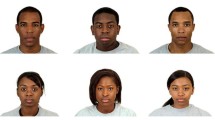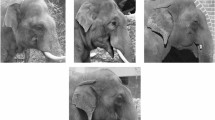Abstract
When threatened, spitting cobras eject venom towards the face of an aggressor. To uncover the relevant cues used by cobras for face recognition we determined how often artificial targets equipped with or without eyes elicited spitting behavior. In addition, we measured whether and how target shape and size influenced the spitting behavior of cobras. Results show that oval- and round-shaped targets were most effective, while triangles with the same surface area as oval ‘face like’ targets hardly elicited spitting. The likelihood of spitting depended on neither the presence, the spatial arrangement (horizontal or vertical) nor the surface texture (shiny or matt) of glass eyes. Most likely, cobras do not specifically aim at the eyes of an offender but at the center of the body part closest to them. As this is usually the face of an animal, this strategy will result in at least one eye of the offender being hit most of the time.





Similar content being viewed by others
References
Barbour T (1922) Rattlesnakes and spitting snakes. Copeia 1922:36–38
Berthé RA, de Pury S, Bleckmann H, Westhoff G (2009) Spitting cobras adjust their venom distribution to target distance. J Comp Physiol A 195:753–757
Broadley DG (1959) The herpetology of Southern Rhodesia. Part 1: snakes. Bull Mus Comp Zool 102:3–100
Burger J, Gochfeld M, Murray BG Jr (1991) Role of a predator’s eye size in risk perception by basking black iguana, Ctenosaura similis. Anim Behav 42:471–476
Cascardi J, Young BA, Husic HD, Sherma J (1999) Protein variation in the venom spat by the red spitting cobra, Naja pallida (Reptilia: Serpentes). Toxicon 37:1271–1279
de Pury S (2006) Spuckverhalten und Spuckmuster von Speikobras (Naja pallida und Naja nigricollis). diploma thesis, Westfälische Wilhelms-Universität Münster
FitzSimons FW (1912) The snakes of South Africa. T. Maskew Miller, Cape Town & Pretoria
Gallup GG, Nash RF, Ellison AL Jr (1971) Tonic immobility as a reaction to predation: artificial eyes as a fear stimulus for chickens. Psychon Sci 23:79–80
Goring Jones MD (1900) Can a cobra eject its poison. J Bombay Nat Hist Soc 13:376
Greene HW (1999) Schlangen: Faszination einer unbekannten Welt. Birkhäuser, Basel
Grüntzig J, Lenz W, Berkemeier B, Mebs D (1985) Experimental studies on the spitting cobra ophthalmia (Naja nigricollis). Graefes Arch Clin Exp 223:196–201
Herzog W, Leonard TR (2002) Force enhancement following stretching of skeletal muscle: a new mechanism. J Exp Biol 205:1275–1283
Hobley CW (1911) Spitting cobra. J East Afr Uganda Nat Hist Soc 1:98–101
Ismail M, Al-Bekairi AM, El-Bedaiwy AM, Abd-El Salam MA (1993a) The ocular effects of spitting cobras: I. The ringhals cobra (Hemachatus haemachatus) venom induced corneal opacification syndrome. Clin Toxicol 31:31–41
Ismail M, Al-Bekairi AM, El-Bedaiwy AM, Abd-El Salam MA (1993b) The ocular effects of spitting cobras: II. Evidence that cardiotoxins are responsible for the corneal opacification syndrome. Clin Toxicol 31:45–62
Koch M, Sachs WB (1927) Über zwei giftspeiende Schlangen, Sepedon haemachates und Naia nigricollis. Zool Anz 70:155–159
Kopstein F (1930) Die Giftschlangen Javas und ihre Bedeutung für den Menschen. Zoomorphologie 19:339–353
O’Brien TJ, Dunlap WP (1975) Tonic immobility in the blue crab (Callinectes sapidus, Rathbun): its relation to threat of predation. J Comp Physiol Psychol 89:86–94
Rasmussen S, Young B, Krimm H (1995) On the “spitting” behavior in cobras (Serpentes: Elapidae). J Zool 237:27–35
Warrell DA, David Omerod L (1976) Snake venom ophthalmia and blindness caused by the spitting cobra Naja nigricollis in Nigeria. Am J Hyg 25:525–529
Westhoff G, Tzschätzsch K, Bleckmann H (2005) The spitting behavior of two species of spitting cobras. J Comp Physiol A 191:873–881
Westhoff G, Boetig M, Bleckmann H, Young BA (2010) Target tracking during venom “spitting” by cobras. J Exp Biol 213:1797–1802
Wüster W, Crookes S, Ineich I et al (2007) The phylogeny of cobras inferred from mitochondrial DNA sequences: evolution of venom spitting and the phylogeography of the African spitting cobras (Serpentes: Elapidae: Naja nigricollis complex). Mol Phylogenet Evol 45:437–453
Young BA, Boetig M, Westhoff G (2009a) Functional bases of the spatial dispersal of venom during cobra “spitting”. Physiol Biochem Zool 82:80–89
Young BA, Boetig M, Westhoff G (2009b) Spitting behaviour of hatchling red spitting cobras Naja pallida. Herpetol J 19:185–191
Acknowledgments
We thank Vera Schlüssel for critically reading the manuscript. This work has been funded by the German Science Foundation (BL 242/15-1). The experiments comply with the “Principles of animal care”, publication No. 86-23, revised 1985 of the National Institute of Health, and with the current laws of Germany.
Author information
Authors and Affiliations
Corresponding author
Rights and permissions
About this article
Cite this article
Berthé, R.A., Westhoff, G. & Bleckmann, H. Potential targets aimed at by spitting cobras when deterring predators from attacking. J Comp Physiol A 199, 335–340 (2013). https://doi.org/10.1007/s00359-013-0796-8
Received:
Revised:
Accepted:
Published:
Issue Date:
DOI: https://doi.org/10.1007/s00359-013-0796-8




